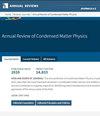集体细胞迁移的物理模型
IF 14.3
1区 物理与天体物理
Q1 PHYSICS, CONDENSED MATTER
Annual Review of Condensed Matter Physics
Pub Date : 2019-05-19
DOI:10.1146/annurev-conmatphys-031218-013516
引用次数: 186
摘要
集体细胞迁移是胚胎发育、伤口愈合和某些类型癌症侵袭的关键驱动力。在这里,我们提供了细胞集体迁移机制的物理视角。我们从控制细胞迁移的细胞-细胞和细胞-底物相互作用的目录开始,我们将其分为位置和定向相互作用。然后,我们回顾了已经开发的物理模型,以解释这些相互作用是如何引起细胞集体运动的。这些模型从亚细胞到超细胞,包括晶格模型、相场模型、主动网络模型、粒子模型和连续体模型。对于每种类型的模型,我们讨论了它的公式、它的局限性以及它成功解释的主要涌现现象。这些现象包括植绒和液固过渡,以及浸润、指压和扩展上皮单层中的机械波。最后,我们概述了集体细胞迁移物理学中的剩余挑战和未来方向。本文章由计算机程序翻译,如有差异,请以英文原文为准。
Physical Models of Collective Cell Migration
Collective cell migration is a key driver of embryonic development, wound healing, and some types of cancer invasion. Here, we provide a physical perspective of the mechanisms underlying collective cell migration. We begin with a catalog of the cell–cell and cell–substrate interactions that govern cell migration, which we classify into positional and orientational interactions. We then review the physical models that have been developed to explain how these interactions give rise to collective cellular movement. These models span the subcellular to the supracellular scales, and they include lattice models, phase-field models, active network models, particle models, and continuum models. For each type of model, we discuss its formulation, its limitations, and the main emergent phenomena that it has successfully explained. These phenomena include flocking and fluid–solid transitions, as well as wetting, fingering, and mechanical waves in spreading epithelial monolayers. We close by outlining remaining challenges and future directions in the physics of collective cell migration.
求助全文
通过发布文献求助,成功后即可免费获取论文全文。
去求助
来源期刊

Annual Review of Condensed Matter Physics
PHYSICS, CONDENSED MATTER-
CiteScore
47.40
自引率
0.90%
发文量
27
期刊介绍:
Since its inception in 2010, the Annual Review of Condensed Matter Physics has been chronicling significant advancements in the field and its related subjects. By highlighting recent developments and offering critical evaluations, the journal actively contributes to the ongoing discourse in condensed matter physics. The latest volume of the journal has transitioned from gated access to open access, facilitated by Annual Reviews' Subscribe to Open initiative. Under this program, all articles are now published under a CC BY license, ensuring broader accessibility and dissemination of knowledge.
 求助内容:
求助内容: 应助结果提醒方式:
应助结果提醒方式:


